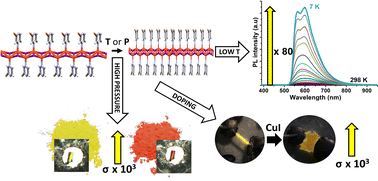A 1D Cu(i)–I-pyrazine coordination polymer with controlled pressure-induced phase transition and opto-electronic response depending on mechanical stimuli, temperature, and CuI content†
Abstract
In this work, we have synthesized a new luminescent and semiconducting coordination polymer (CP) based on [CuI(PyzBr)]n staircase double Cu(I)–I chains where the 2-bromopyrazine ligand (PyzBr) was selected as the N-donor ligand due to its wide commercial availability in liquid whereas copper iodide (CuI) is a promising p-type wide bandgap semiconductor for optoelectronic applications. The obtained CP has a reversible luminescent response to temperature and pressure. Upon decreasing the temperature, its emission increases drastically. Structure determination by single-crystal X-ray diffraction at 250 and 100 K allows us to understand its response to temperature. It also presents an electrical response to pressure. Its electrical conductivity increases with quasi-hydrostatic pressure. This result has been corroborated by spin-polarized single-point DFT band structure calculations. In addition, a discontinuity is found in the conductivity near 5 GPa, supporting the existence of a phase transition which is corroborated by an important structural transformation around these pressures. This conclusion is consistent with optical-absorption experiments, which show that the electronic band gap decreases with pressure and also has a discontinuity at ≈5 GPa. Its structural changes are directly related to the high Cu(I)–I chain structural flexibility, which allows the shortening of the Cu⋯Cu distances via cuprophilic interactions. Moreover, the control of size, defects, and CuI content allows modifying its emission and electrical conductivity. Control over the amount of CuI is performed by the synthetic method. On the one hand, the solvent-free mechanical synthesis allows us to obtain [CuI(PyzBr)]n polycrystals with a maximum percentage of 2.5% of CuI and, on the other, recrystallization of the polycrystals in acetonitrile produces single crystals. The size reduction and the generation of defects are carried out by employing mechanical stress including fracture. The experimental data are confirmed with the help of theoretical calculations.



 Please wait while we load your content...
Please wait while we load your content...